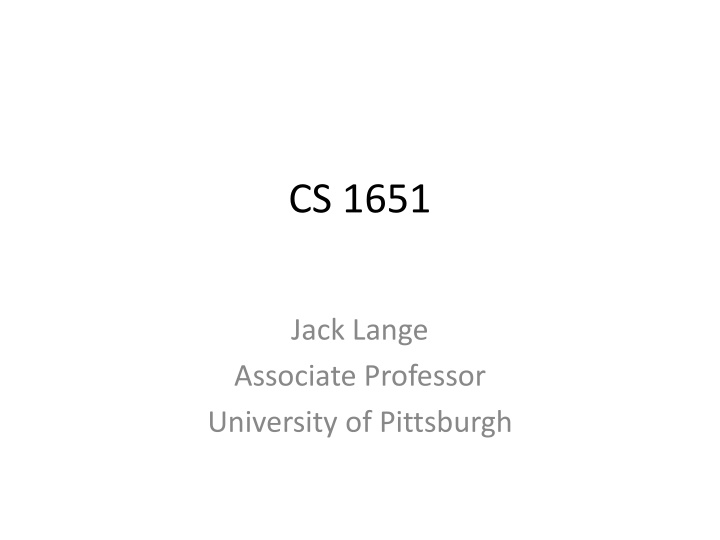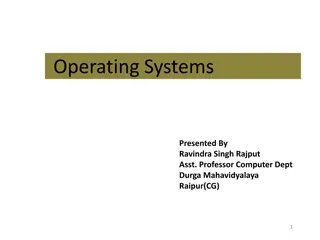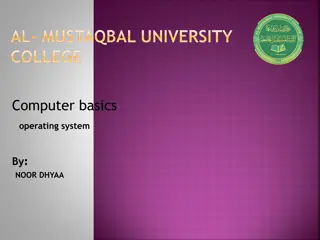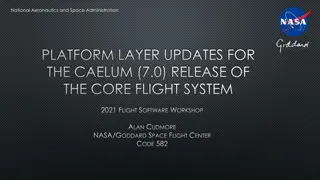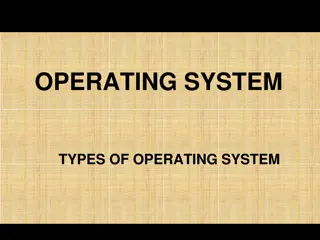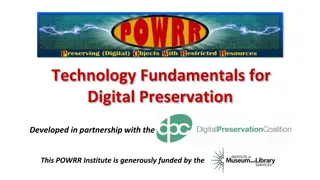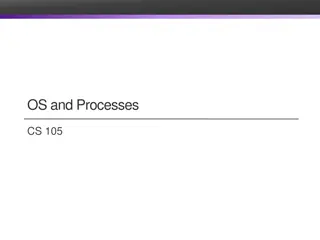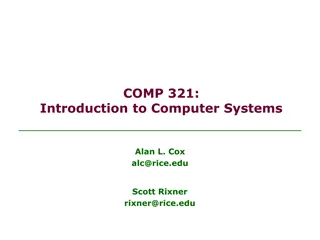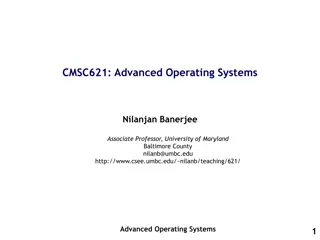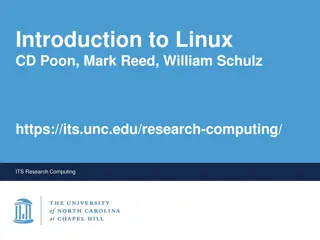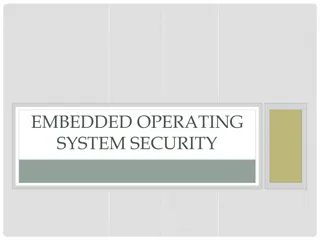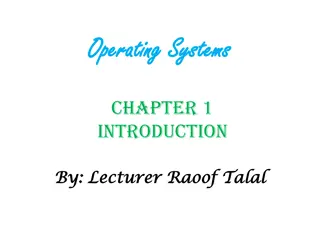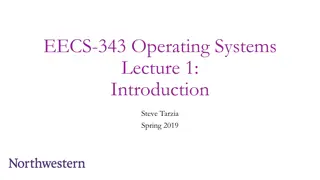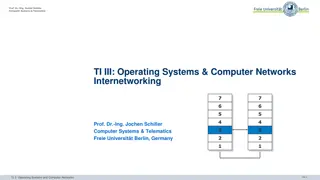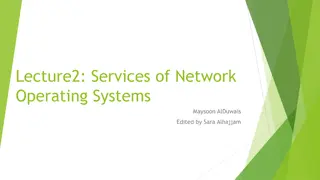Operating Systems: Course Overview and Objectives
Operating Systems, Course Overview, System Design, Linux Internals, Systems Research
Download Presentation

Please find below an Image/Link to download the presentation.
The content on the website is provided AS IS for your information and personal use only. It may not be sold, licensed, or shared on other websites without obtaining consent from the author.If you encounter any issues during the download, it is possible that the publisher has removed the file from their server.
You are allowed to download the files provided on this website for personal or commercial use, subject to the condition that they are used lawfully. All files are the property of their respective owners.
The content on the website is provided AS IS for your information and personal use only. It may not be sold, licensed, or shared on other websites without obtaining consent from the author.
E N D
Presentation Transcript
CS 1651 Jack Lange Associate Professor University of Pittsburgh
Course Objectives Gain practical experience with current systems x86 and Linux Understand Linux internals Understand historical background of OS design Learn how modern systems are designed and operated Gain some exposure to systems research Explore hot current topics
Administrative Stuff Instructor: Jack Lange Email: jacklange@cs.pitt.edu Office: Sennott Square #5407 Office Hours: Tues 2-4PM Course homepage Everything will be made available through Canvas Grading 4 Projects (60%) Final (30%) Participation (10%)
Projects Work in groups of 2 C is required Some assembly will ne needed Highly Recommended: OS or having some familiarity with Unix systems programming, preferably in C or C++ All projects are in C 1-9
Textbooks See Syllabus on Canvas Primary: Linux Kernel Development Robert Love Secondary: Intel x86 Architectural Manuals (Vols. 2 and 3 are necessary for Projects) Linux Device Drivers (Very helpful for Projects) Jonathan Corbet, Alessandro Rubini, and Greg Kroah-Hartman Understanding the Linux Kernel, Marco Cesati and Daniel P. Bovet
Why learn about Operating Systems? Tangible reasons Build or modify a real operating system Administer and use system well Tune application performance Intangibles Intrinsic curiosity Understand how your computer works Gain/apply knowledge in other areas of Computer Science Computer architecture and devices Synchronization in programming languages Data structures and algorithms Performance analysis Challenge of designing large, complex systems
What is an operating System Not easy to define: Users Applications Operating System Hardware OS: Everything that isn t an application or hardware OS: Software that abstract hardware into a useful form for applications Standard Library Resource Coordinator
First Function: Standard Library Advantages of standard library Allow applications to reuse common facilities Make different devices look the same Provide higher level abstractions Challenges What are the right abstractions?
Second Function: Resource Coordinator Resource: Anything valuable (e.g. CPU, memory, disk, network) Advantages of resource coordinator Virtualize resource so multiple users/applications can share Protect applications from one another Provide efficient and fair access to resources Challenges What mechanisms? What policies?
What Functionality in OS? No single right answer Desired functionality depends on outside factors Technology Changes Expectations Users & Applications Operating System Computer Architecture OS must adapt Change abstractions provided to users Change algorithms to implement those abstractions Change low-level interfaces to deal with new hardware Current operating systems driven by technological evolution
Outlook on Operating Systems Will OSs in 2025 still resemble the Unix-like consensus of today, or will a very different design achieve widespread adoption? Dejan Milojicic and Timothy Roscoe. 2016. Outlook on Operating Systems. Computer 49, 1 (January 2016), 43-51. DOI=http://dx.doi.org/10.1109/MC.2016.19 http://ieeexplore.ieee.org/document/7383138/
Types of OSes Monolithic kernels Linux, Windows, BSDs, UniKernel / Library OS SunMOS, Mirage, Exokernels Microkernels MINIX Multi-kernels Barrelfish Lightweight Kernels Kitten (my work), Catamount, IBM CNK Co-kernels Pisces (my work), McKernel, Intel mOS
Operating System Architectures What do the applications really need? Really: What do we think the applications need? What abstractions should OS provide? Abstractions == Combination of mechanisms and policies Performance OS abstractions add overhead Hardware Capabilities OS abstractions inherently reduce the capabilities of the hardware Working with others OS abstractions determine how applications communicate Isolation OS abstractions determine amount of isolation Both for security and performance
Monolithic Kernels Jack of all trades, master of none Defacto standard OS design approach Linux, Windows, etc Goal is universal compatibility Support all possible hardware Support all possible applications Easy to use Does everything good enough Many high level abstractions Large and complex Linux kernel source code is 850MB Constant security vulnerabilities
Unikernel Link OS to application as a library Application and OS are a single entity OS Library: Abstractions to interface directly with hardware Policies to manage isolation in application Very high performance Minimal and highly specialized abstractions No context switching No protection! Application runs as the kernel Application has control over entire machine Very low system utilization Only one application at a time can run on a machine
Unikernel use cases Supercomputing / HPC Historically extreme scale HPC systems have run a single app at a time 1990 s early 2000 s Early OS s could not scale Unikernels were adopted to fill the gap Fell out of favor as OSes (Linux) caught up Cloud (Virtual Machines) Virtualization sparked a renaissance in unikernels Performance benefits without the costs Multiple virtualized unikernels can run on a single system Unikernels can actually increase cloud system utilization Why?
Microkernels Minimalistic kernel Provide very few mechanisms Basic HW protection/isolation and IPC channels Higher level abstractions implemented in user space as servers Clients request functionality from a specific server OS as a distributed system (designed by Tannenbaum) Client-server communicate via message passing Performance depends on a very fast message passing mechanism (the most important OS mechanism) Why Message Passing for IPC?
Exokernels A combination of micro- and uni- kernels Very small kernel provides basic HW protection No OS provided IPC mechanisms Applications provide own higher level services Applications can choose their level of abstraction Implement their own services
Multi-kernels Your computer is already a distributed system. Why isn t your OS? Goal: Make microkernels scalable to modern systems Modern many-/multi-core systems are basically distributed systems Distributed Operating System Communicate via asynchronous messages Shared memory doesn t work in a distributed system Replicate state, but use messages to keep it consistent Support heterogeneous architectures
Lightweight kernels (LWKs) Designed specifically for extreme scale HPC Large scale supercomputers in the upper ranks of the top 500 (http://www.top500.org) Large scale, but small world Small number of applications Small number of application requirements Small number of systems LWKs provide a stripped down OS environment Provide the OS features needed and nothing else Leaky microkernel Will provide functionality in OS when it makes sense What is a Lightweight Kernel? http://dl.acm.org/citation.cfm?id=2768414
Lightweight Co-kernels Fact: Programmers are lazy Everyone just wants to use Linux LWKs lack many Linux features (i.e. shells) Co-kernels couple an LWK and a FWK (Linux) on the same machine Missing features in LWK can be provided by Linux Machine can be managed via Linux Applications can be launched onto an LWK partition Best of both worlds Functionality of Linux Performance of an LWK for HPC Apps Non-interference between the two partitions
Hypervisors/VMMs A Virtual Machine is a software version of the hardware state of a computer system An operating system running within a virtual machine is called a guest operating system
Virtual Machine Monitors (VMMs) Virtual Machines run an OS as an application Implements hardware interface in software Ways to build a VMM (Type 1 vs Type 2) Type 2: VMs run as apps in a native OS VMWare Player, KVM, VirtualBox, Palacios (me again) Type 1: Hypervisor is the native OS No native apps, everything runs in a VM Xen, VMWare ES
Summary There is more to OSes than Unix and Windows Lots of different ideas, approaches, and hardware OSes try to answer the question: How do I run this application on this hardware? What about the future? No class on Monday Instead you can listen to me and others talk about future HPC OS directions (if you want to, its not required) https://www.orau.gov/OSRoundtable2021
Some References Andrew Baumann, Simon Peter, Adrian Sch pbach, Akhilesh Singhania, Timothy Roscoe, Paul Barham, and Rebecca Isaacs. 2009. Your computer is already a distributed system. why isn't your OS?. In Proceedings of the 12th conference on Hot topics in operating systems (HotOS'09). USENIX Association, Berkeley, CA, USA, 12-12. Avi Kivity, Dor Laor, Glauber Costa, Pekka Enberg, Nadav Har'El, Don Marti, and Vlad Zolotarov. 2014. OSv: optimizing the operating system for virtual machines. In Proceedings of the 2014 USENIX conference on USENIX Annual Technical Conference (USENIX ATC'14), Garth Gibson and Nickolai Zeldovich (Eds.). USENIX Association, Berkeley, CA, USA, 61-72. Simon Peter, Jialin Li, Irene Zhang, Dan R. K. Ports, Doug Woos, Arvind Krishnamurthy, Thomas Anderson, and Timothy Roscoe. 2014. Arrakis: the operating system is the control plane. In Proceedings of the 11th USENIX conference on Operating Systems Design and Implementation(OSDI'14). USENIX Association, Berkeley, CA, USA, 1-16. Tanenbaum-Torvalds Debate (https://groups.google.com/forum/#!topic/comp.os.minix/wlhw16QWltI%5B1-25%5D) Jorrit N. Herder, Herbert Bos, Ben Gras, Philip Homburg, and Andrew S. Tanenbaum. 2006. MINIX 3: a highly reliable, self- repairing operating system. SIGOPS Oper. Syst. Rev. 40, 3 (July 2006), 80-89. DOI=http://dx.doi.org/10.1145/1151374.1151391 J. Ouyang, B. Kocoloski, J. Lange and K. Pedretti, Achieving Performance Isolation with Lightweight Co-Kernels, Proceedings of the 24th International ACM Symposium on High Performance Parallel and Distributed Computing, (HPDC 2015) J. Lange, K. Pedretti, T. Hudson, P. Dinda, Z. Cui, L. Xia, P. Bridges, M.Levenhagen, R. Brightwell, A. Gocke, S. Jaconette, Palacios: A New Open Source Virtual Machine Monitor for Scalable High Performance Computing, Proceedings of the 24th IEEE International Parallel and Distributed Processing Symposium, (IPDPS 2010)
